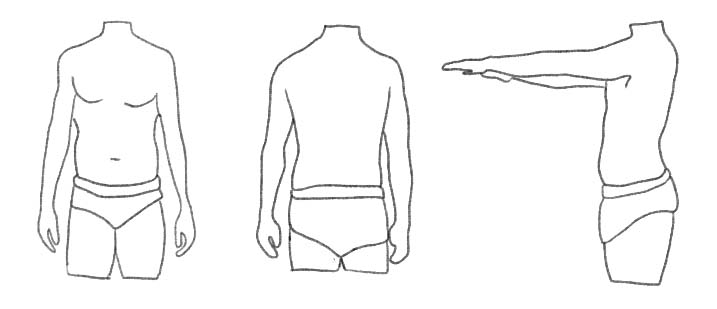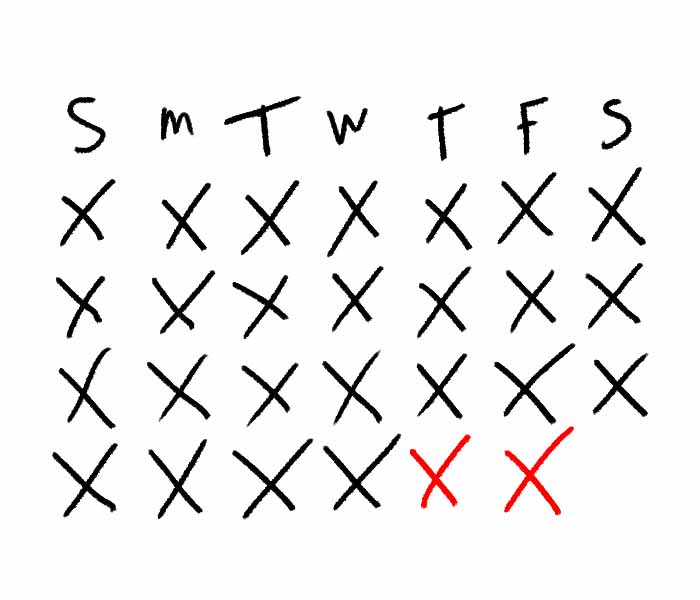60-Day Challenge
There are two goals.
First, stay consistent. Complete all 60 days of the challenge. Second, lose fat. (There’s a good chance you’ll gain some muscle, but muscle growth should be seen as a side effect. If it happens, it happens.) Losing fat is a byproduct of (a) staying consistent and (b) having a solid strategy.
You should track your progress towards these goals. This will help you stay motivated. Motivation is momentum. You need to see the results of your hard work, or else you’ll get discouraged. Tracking will also help you troubleshoot potential problems.
FIRST:
Track consistency.
Get a calendar. Preferably a wall calendar. Something that allows you to see an entire month displayed in blocks. You’re going to use Seinfeld’s strategy to help you stay consistent (even though Seinfeld never used this strategy).
Legend says Jerry Seinfeld challenged himself to write a joke every single day. When he wrote his daily joke, he’d take a large Sharpie marker and draw an “X” over the day on his calendar. After a few days, he had a chain. His only objective was to not break the chain.
Do the same thing.
DON’T. BREAK. THE. CHAIN.
Anytime you have the urge of taking the day off, think of the chain. Think of the void you’ll create on the calendar. If you string together 60 “X”s on your calendar, good things will happen.
SECOND:
Track weight.
Weigh yourself every morning, preferably before you eat or drink anything (to standardize the measurement). Keep a running log in whatever format is easiest for you. Maybe you keep a notebook and pen by the scale. Maybe you take a picture of the number with your phone. Doesn’t matter.
Even though you’re weighing yourself daily, you shouldn’t obsess over how much you weigh from one day to another. You should, instead, focus on the weekly average. I built a minimalist spreadsheet you can use to help calculate weekly average weight:
Input your daily weight into the colored cells. Your average for the week will be calculated. After, enter your average weight in the appropriate cell, to create a running weekly log.
Expectations?
If your diet is dialed in, you can expect to lose one pound of fat per week, on average. Don’t expect the scale to respond in a nice and neat linear manner, like:
Monday = 200 pounds
Tuesday = 199.85 pounds
Wednesday = 199.70 pounds
Thursday 199.55 pounds…
This will NOT happen. “Weight” is a measurement of everything inside of you, not just fat. As they say, the fastest way to lose weight is to chop off an arm. Some of the constituents that create your “weight” aren’t very stable. For instance, your weight can fluctuate by pounds on a daily basis, thanks to fluctuating fluid levels.
Perhaps you ate a burrito loaded with sodium last night. Chances are, your body is holding more water today, as compared to yesterday. You might weigh a few more pounds. Or perhaps some of said burrito is stuck in your intestines. Boom. You might weigh a few more pounds.
In either scenario, you weigh more, but you have the same amount of body fat.
Most short-term fluctuations in weight are due to fluctuating FLUID levels, not fluctuating fat levels.
This is one of the reasons why you might experience rapid weight loss during the first few weeks; don’t be surprised if you lose five pounds the first week. Don’t let these initial results fool you. This “extra” weight loss might be some fat loss, but it probably has more to do with fluid loss.
The average will trend towards a one-pound loss of fat per week (until you reach lower body fat levels)… but this won’t always translate to losing one pound per week. You might be gaining muscle as you lose fat, which can result in zero change in scale weight. This is why I also recommend…
THIRD:
Track visuals.
Take pictures of yourself once every week. Capture the front, side, and back of your body from neck to knees. Don’t flex. Relax.

To standardize the pictures, use the same camera. Take the pictures in the same room with the same lighting.
Also, think about creating a separate folder on your phone for these pictures. Remember when you were showing grandma some pictures on your phone? “Just swipe right,” you said, hoping that it wouldn’t lead to that one picture of you snorting coke off of a Giraffe’s scrotum. Or whatever.
Expectations?
Visual progress from week to week won’t be HYYYOOUGGGGEE. But, monthly (perhaps biweekly) you’ll see things — things that you wouldn’t otherwise have been aware of because you’re in your skin 24/7. Noticing subtle changes is difficult.
Unfortunately, visual progress is (sometimes) tough to evaluate. A lot of people think they’re getting too scrawny (losing muscle) as they lose weight, but the truth is that they’re just revealing the non-fat tissue underneath what’s already there. MOST PEOPLE OVERESTIMATE HOW MUCH MUSCLE THEY HAVE UNDERNEATH THEIR FAT. This is why I also recommend…
FOURTH:
Track circumference.
Measure your waist circumference once a week. (There’s room for a weekly circumference measurement in the spreadsheet I gave you earlier — the one that calculates your weekly average weight.) Wrap a flexible measuring tape around your belly button. Make a perfect circle; make sure the tape is parallel to the floor. If the line is crooked, your measurement will be, too. Pull the tape so that it fits the skin, but doesn’t squeeze it into your fat. And make sure you aren’t flexing. Relax.
(If you carry the majority of your fat around your hips and legs, you should also track your hip circumference. Measure the largest portion of your hips — usually right around the mid-butt. Make a perfect circle; make sure the tape is parallel to the floor; pull the tape so that it fits the skin, but doesn’t squeeze it into your fat; make sure you aren’t flexing — relax.)
Expectations?
Tracking your waist circumference is great because your waist isn’t heavily influenced by muscle growth. In other words, if your waist circumference is shrinking, you’re probably losing fat even if you aren’t losing weight.
